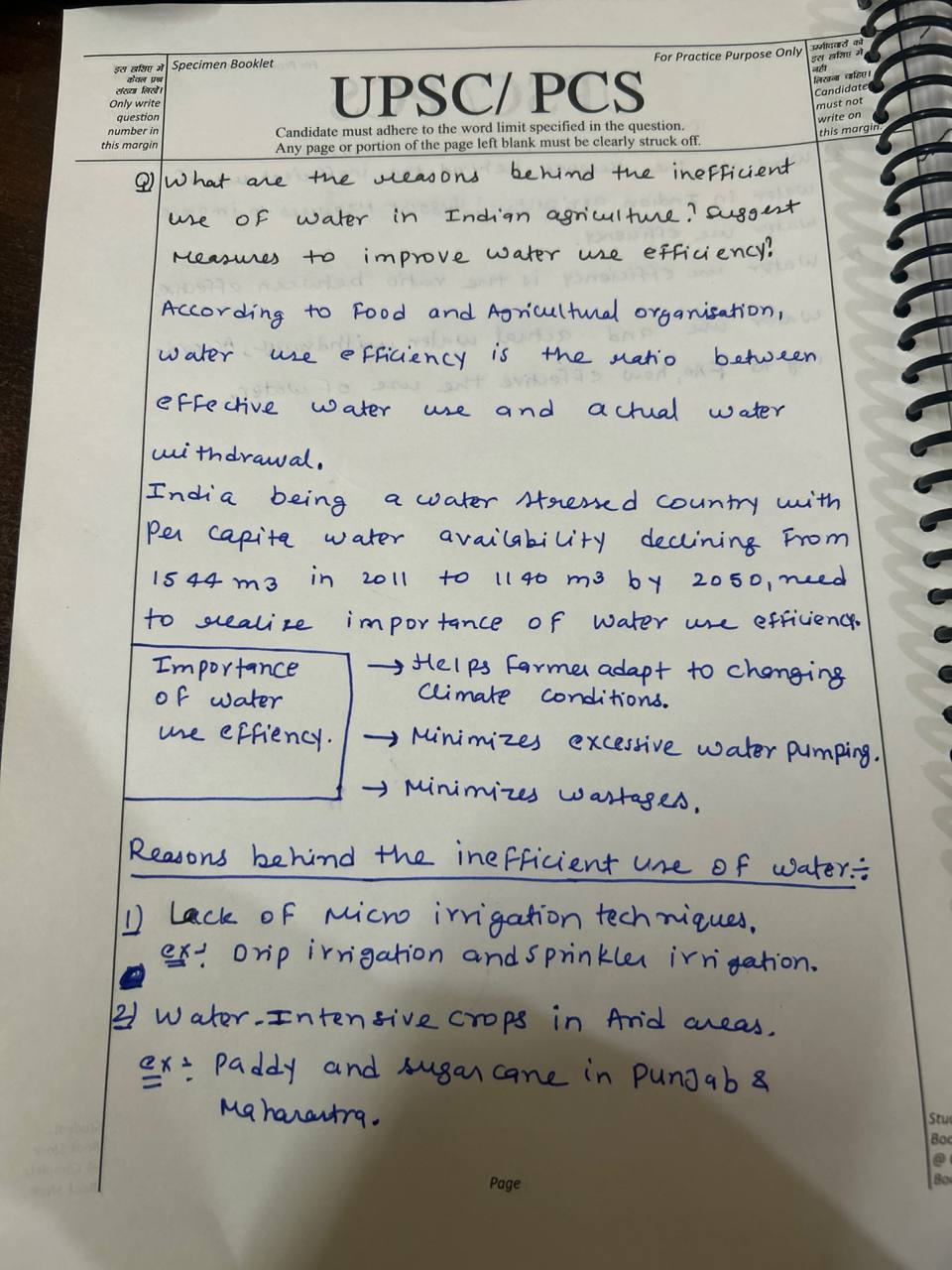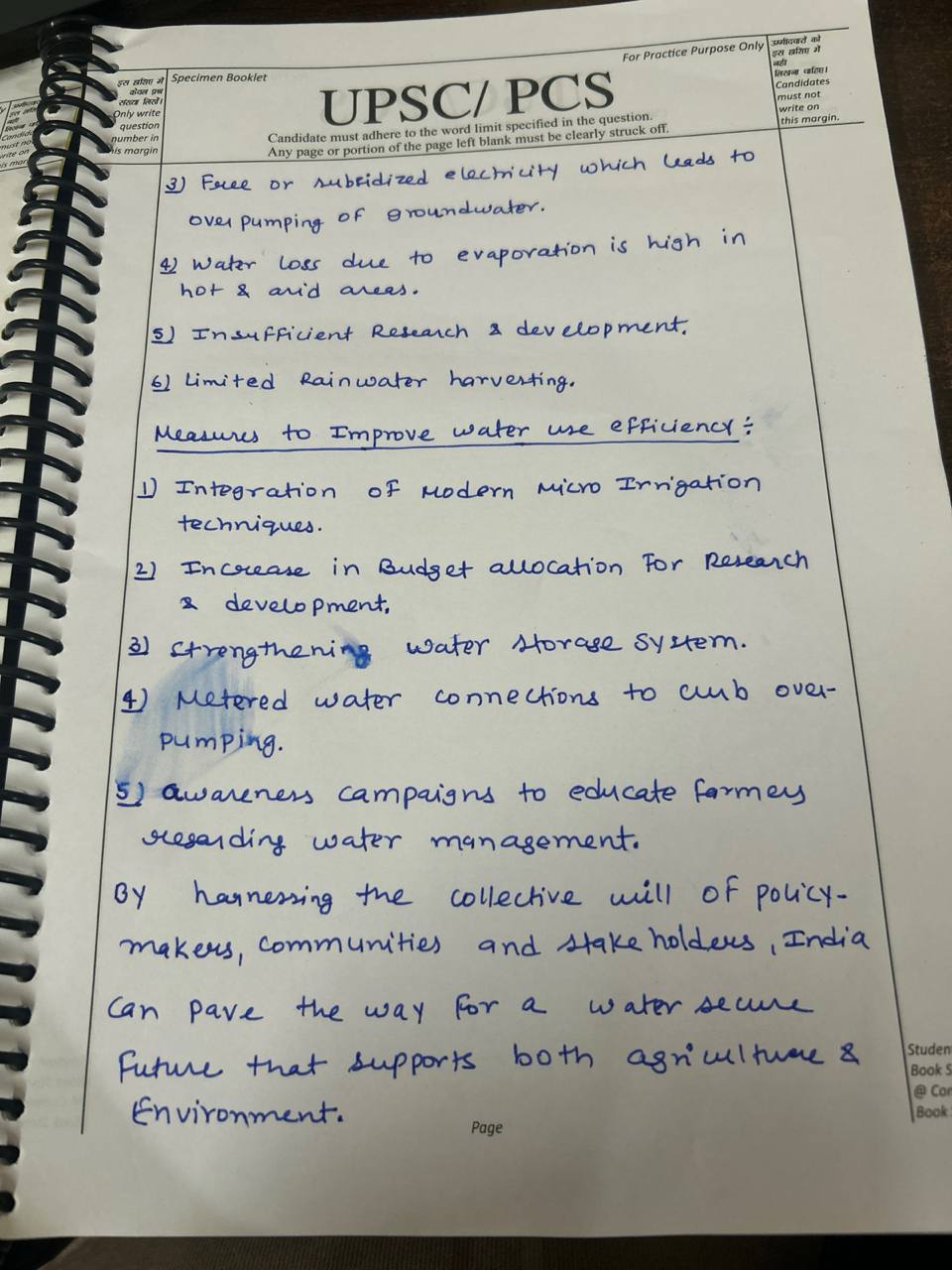Examine the success of the government’s initiatives to update and renovate the antiquated irrigation infrastructure, including large- and medium-scale irrigation projects, and evaluate the difficulties and limitations in guaranteeing fair distribution of water and increased water efficiency.
Challenges in Managing Groundwater Resources and the Effectiveness of Government Policies 1. Overview of Groundwater Management Challenges Overexploitation of Groundwater Intensive Use: Overexploitation occurs when groundwater extraction exceeds the natural recharge rate, leading to declining waterRead more
Challenges in Managing Groundwater Resources and the Effectiveness of Government Policies
1. Overview of Groundwater Management Challenges
Overexploitation of Groundwater
- Intensive Use: Overexploitation occurs when groundwater extraction exceeds the natural recharge rate, leading to declining water tables and depletion of aquifers.
- Recent Example: In Punjab, excessive groundwater extraction for irrigation has caused a significant drop in water levels, with some regions experiencing water tables falling below 300 meters.
Depletion of Aquifers
- Aquifer Depletion: Continuous overuse results in the depletion of aquifers, reducing their capacity to store water and leading to long-term water scarcity.
- Recent Example: In Rajasthan, the depletion of the Jaipur aquifer has led to severe water shortages and has impacted agricultural productivity.
Water Quality Issues
- Contamination: Overexploitation can lead to the intrusion of contaminants such as arsenic, fluoride, and nitrate into groundwater, affecting water quality and public health.
- Recent Example: In West Bengal, arsenic contamination in groundwater has been linked to serious health issues, including cancer and skin diseases, due to the overuse of shallow aquifers.
2. Government Policies and Regulations
Groundwater (Sustainable Management) Bill
Objectives and Provisions
- Bill Overview: The Groundwater (Sustainable Management) Bill aims to regulate the extraction and use of groundwater to ensure sustainability and prevent overexploitation.
- Key Provisions: Includes measures for monitoring groundwater levels, regulation of extraction, and promotion of sustainable practices such as rainwater harvesting and artificial recharge.
Recent Example
- Bill Status: As of 2024, the Bill is in the legislative process and has yet to be enacted into law. It represents a critical step towards formalizing groundwater management practices at the national level.
3. Effectiveness of Existing Policies
National Water Policy
Integrated Approach
- Policy Framework: The National Water Policy emphasizes integrated water resources management, including the regulation of groundwater use and the promotion of sustainable practices.
- Recent Example: The 2012 policy update encourages states to implement measures for groundwater conservation and promotes the use of technology for monitoring water resources.
Pradhan Mantri Krishi Sinchai Yojana (PMKSY)
Water Efficiency
- Support for Efficient Use: PMKSY promotes water-saving technologies like drip irrigation, which can indirectly help reduce the pressure on groundwater resources.
- Recent Example: In Maharashtra, the adoption of drip irrigation under PMKSY has led to more efficient water use and reduced dependency on groundwater for agriculture.
State-Level Initiatives
Local Regulations
- State Efforts: Various states have implemented their own regulations and programs to address groundwater issues, such as restricting groundwater extraction and promoting recharge projects.
- Recent Example: Gujarat has introduced a state groundwater policy that includes measures for regulating extraction and encouraging the use of rainwater harvesting.
4. Evaluation of Policy Effectiveness
Implementation Challenges
- Enforcement Issues: Effective enforcement of groundwater regulations is often hampered by inadequate monitoring infrastructure and lack of coordination between agencies.
- Recent Example: In Karnataka, challenges in enforcing groundwater regulations have led to continued overexploitation despite existing policies.
Funding and Resources
- Resource Allocation: Limited financial resources and insufficient infrastructure for groundwater monitoring and management can affect the implementation of policies.
- Recent Example: In Uttar Pradesh, inadequate funding has impacted the ability to implement groundwater recharge projects effectively.
Public Awareness and Participation
- Engagement: Increasing public awareness and involving local communities in groundwater management are essential for the success of policies.
- Recent Example: In Madhya Pradesh, community-based groundwater management initiatives have shown positive results in improving water conservation practices at the grassroots level.
5. Recommendations for Improving Groundwater Management
Strengthening Legislation and Enforcement
- Enhanced Regulations: Finalizing and enforcing the Groundwater (Sustainable Management) Bill and similar regulations with a focus on robust monitoring and compliance mechanisms.
- Recommendation: Strengthening the enforcement framework and increasing investments in groundwater monitoring infrastructure.
Promoting Technological Solutions
- Innovative Technologies: Leveraging technology for better monitoring, data collection, and management of groundwater resources, such as satellite imagery and remote sensing.
- Recommendation: Investing in advanced technologies for real-time groundwater monitoring and management.
Encouraging Community Participation
- Local Involvement: Encouraging community participation in groundwater management through awareness programs and local water user associations.
- Recommendation: Developing programs that engage local communities in groundwater conservation and management efforts.
Investing in Sustainable Practices
- Adoption of Sustainable Practices: Promoting sustainable agricultural practices and water-saving technologies to reduce the dependency on groundwater.
- Recommendation: Expanding support for practices like rainwater harvesting, artificial recharge, and efficient irrigation techniques.
6. Conclusion
Managing groundwater resources effectively is crucial for ensuring sustainable water availability and addressing the challenges of overexploitation and aquifer depletion. While government policies such as the Groundwater (Sustainable Management) Bill represent important steps toward better regulation and management, challenges related to enforcement, funding, and public awareness remain. By strengthening legislation, promoting technological solutions, encouraging community participation, and investing in sustainable practices, India can improve groundwater management and support the long-term sustainability of its water resources.
See less






Evaluation of Government Efforts to Modernize and Rehabilitate Aging Irrigation Infrastructure 1. Overview of Government Efforts Modernization and Rehabilitation Initiatives Pradhan Mantri Krishi Sinchai Yojana (PMKSY): Launched in 2015, PMKSY aims to enhance irrigation infrastructure through modernRead more
Evaluation of Government Efforts to Modernize and Rehabilitate Aging Irrigation Infrastructure
1. Overview of Government Efforts
Modernization and Rehabilitation Initiatives
Recent Examples
2. Effectiveness of Modernization Efforts
Improvement in Irrigation Infrastructure
Increased Irrigation Coverage
Enhanced Water Use Efficiency
3. Challenges and Constraints
Aging Infrastructure
Equitable Water Distribution
Financial Constraints
Technical and Administrative Issues
4. Recommendations for Improvement
Strengthening Maintenance Programs
Promoting Technological Integration
Ensuring Equitable Distribution
Increasing Financial Investment
Improving Project Management
5. Conclusion
The government’s efforts to modernize and rehabilitate aging irrigation infrastructure have led to significant improvements in water delivery, irrigation coverage, and water use efficiency. However, challenges such as aging infrastructure, equitable water distribution, financial constraints, and technical issues persist. Addressing these challenges through strengthened maintenance programs, technological integration, equitable distribution mechanisms, increased financial investment, and improved project management will be crucial for ensuring the continued effectiveness and sustainability of irrigation modernization efforts in India.
See less